lock BMW 340I XDRIVE SEDAN 2016 Owner's Guide
[x] Cancel search | Manufacturer: BMW, Model Year: 2016, Model line: 340I XDRIVE SEDAN, Model: BMW 340I XDRIVE SEDAN 2016Pages: 257, PDF Size: 5.55 MB
Page 83 of 257
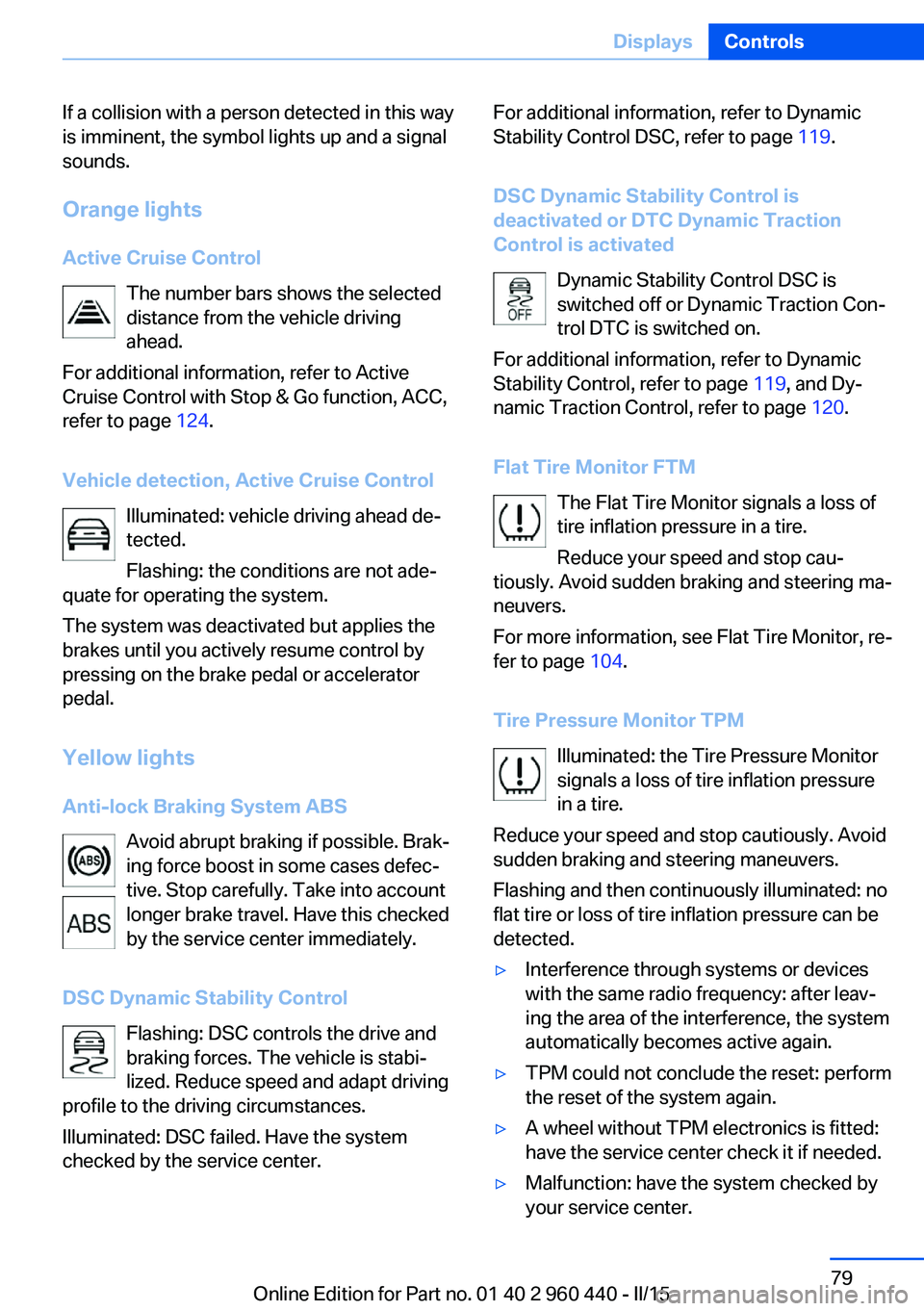
If a collision with a person detected in this way
is imminent, the symbol lights up and a signal
sounds.
Orange lights Active Cruise Control The number bars shows the selected
distance from the vehicle driving
ahead.
For additional information, refer to Active
Cruise Control with Stop & Go function, ACC,
refer to page 124.
Vehicle detection, Active Cruise Control Illuminated: vehicle driving ahead de‚Äź
tected.
Flashing: the conditions are not ade‚Äź
quate for operating the system.
The system was deactivated but applies the
brakes until you actively resume control by
pressing on the brake pedal or accelerator
pedal.
Yellow lights
Anti-lock Braking System ABS Avoid abrupt braking if possible. Brak‚Äź
ing force boost in some cases defec‚Äź
tive. Stop carefully. Take into account
longer brake travel. Have this checked
by the service center immediately.
DSC Dynamic Stability Control Flashing: DSC controls the drive and
braking forces. The vehicle is stabi‚Äź
lized. Reduce speed and adapt driving
profile to the driving circumstances.
Illuminated: DSC failed. Have the system
checked by the service center.For additional information, refer to Dynamic
Stability Control DSC, refer to page 119.
DSC Dynamic Stability Control is
deactivated or DTC Dynamic Traction
Control is activated
Dynamic Stability Control DSC is
switched off or Dynamic Traction Con‚Äź
trol DTC is switched on.
For additional information, refer to Dynamic
Stability Control, refer to page 119, and Dy‚Äź
namic Traction Control, refer to page 120.
Flat Tire Monitor FTM The Flat Tire Monitor signals a loss of
tire inflation pressure in a tire.
Reduce your speed and stop cau‚Äź
tiously. Avoid sudden braking and steering ma‚Äź
neuvers.
For more information, see Flat Tire Monitor, re‚Äź
fer to page 104.
Tire Pressure Monitor TPM Illuminated: the Tire Pressure Monitor
signals a loss of tire inflation pressure
in a tire.
Reduce your speed and stop cautiously. Avoid
sudden braking and steering maneuvers.
Flashing and then continuously illuminated: no
flat tire or loss of tire inflation pressure can be
detected.‚Ė∑Interference through systems or devices
with the same radio frequency: after leav‚Äź
ing the area of the interference, the system
automatically becomes active again.‚Ė∑TPM could not conclude the reset: perform
the reset of the system again.‚Ė∑A wheel without TPM electronics is fitted:
have the service center check it if needed.‚Ė∑Malfunction: have the system checked by
your service center.Seite 79DisplaysControls79
Online Edition for Part no. 01 40 2 960 440 - II/15
Page 96 of 257
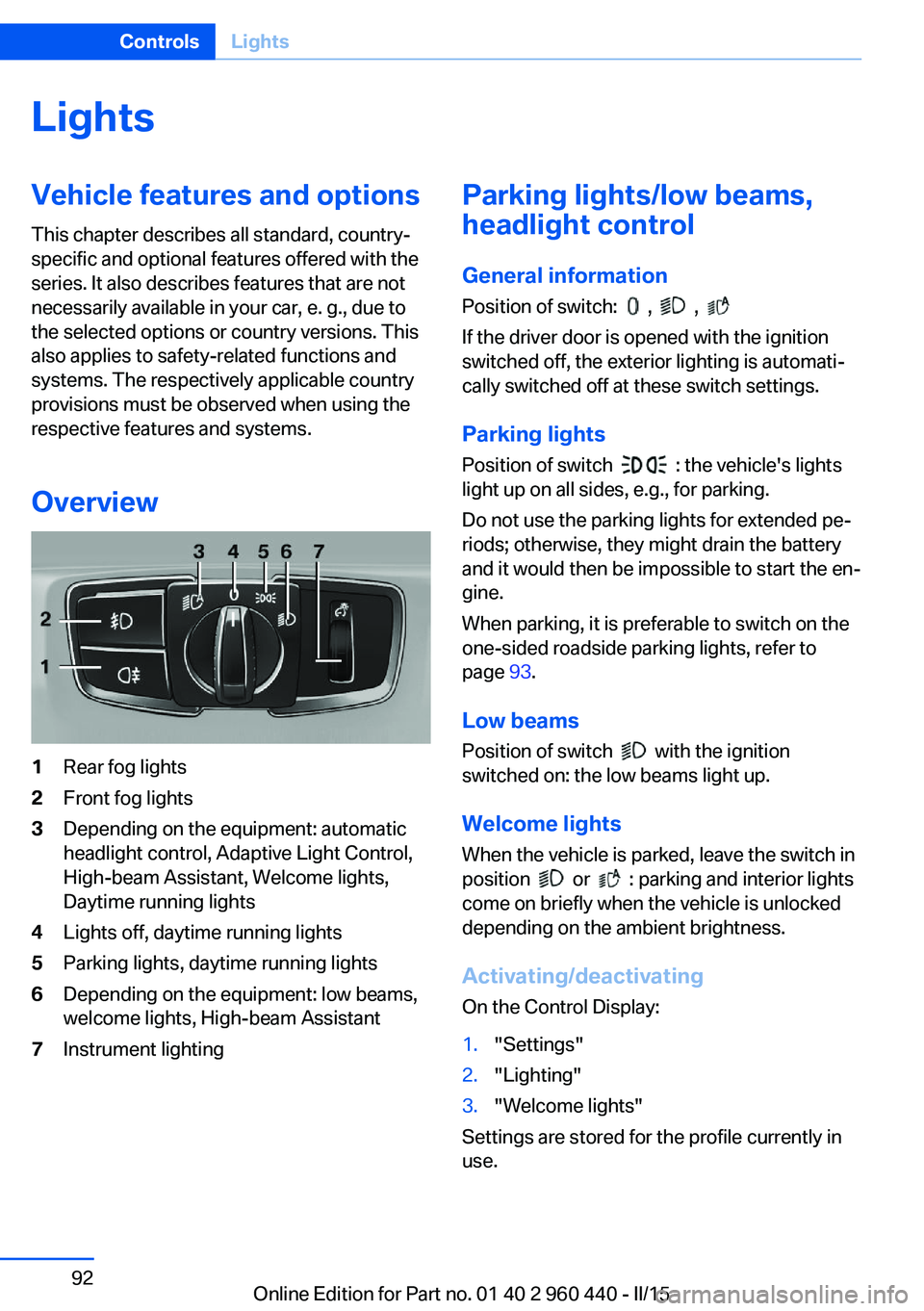
LightsVehicle features and optionsThis chapter describes all standard, country-
specific and optional features offered with the
series. It also describes features that are not
necessarily available in your car, e. g., due to
the selected options or country versions. This
also applies to safety-related functions and
systems. The respectively applicable country
provisions must be observed when using the
respective features and systems.
Overview1Rear fog lights2Front fog lights3Depending on the equipment: automatic
headlight control, Adaptive Light Control,
High-beam Assistant, Welcome lights,
Daytime running lights4Lights off, daytime running lights5Parking lights, daytime running lights6Depending on the equipment: low beams,
welcome lights, High-beam Assistant7Instrument lightingParking lights/low beams,
headlight control
General information
Position of switch:
, ,
If the driver door is opened with the ignition
switched off, the exterior lighting is automati‚Äź
cally switched off at these switch settings.
Parking lights
Position of switch
: the vehicle's lights
light up on all sides, e.g., for parking.
Do not use the parking lights for extended pe‚Äź
riods; otherwise, they might drain the battery
and it would then be impossible to start the en‚Äź
gine.
When parking, it is preferable to switch on the
one-sided roadside parking lights, refer to
page 93.
Low beams Position of switch
with the ignition
switched on: the low beams light up.
Welcome lights
When the vehicle is parked, leave the switch in
position
or : parking and interior lights
come on briefly when the vehicle is unlocked
depending on the ambient brightness.
Activating/deactivating
On the Control Display:
1."Settings"2."Lighting"3."Welcome lights"
Settings are stored for the profile currently in
use.
Seite 92ControlsLights92
Online Edition for Part no. 01 40 2 960 440 - II/15
Page 100 of 257
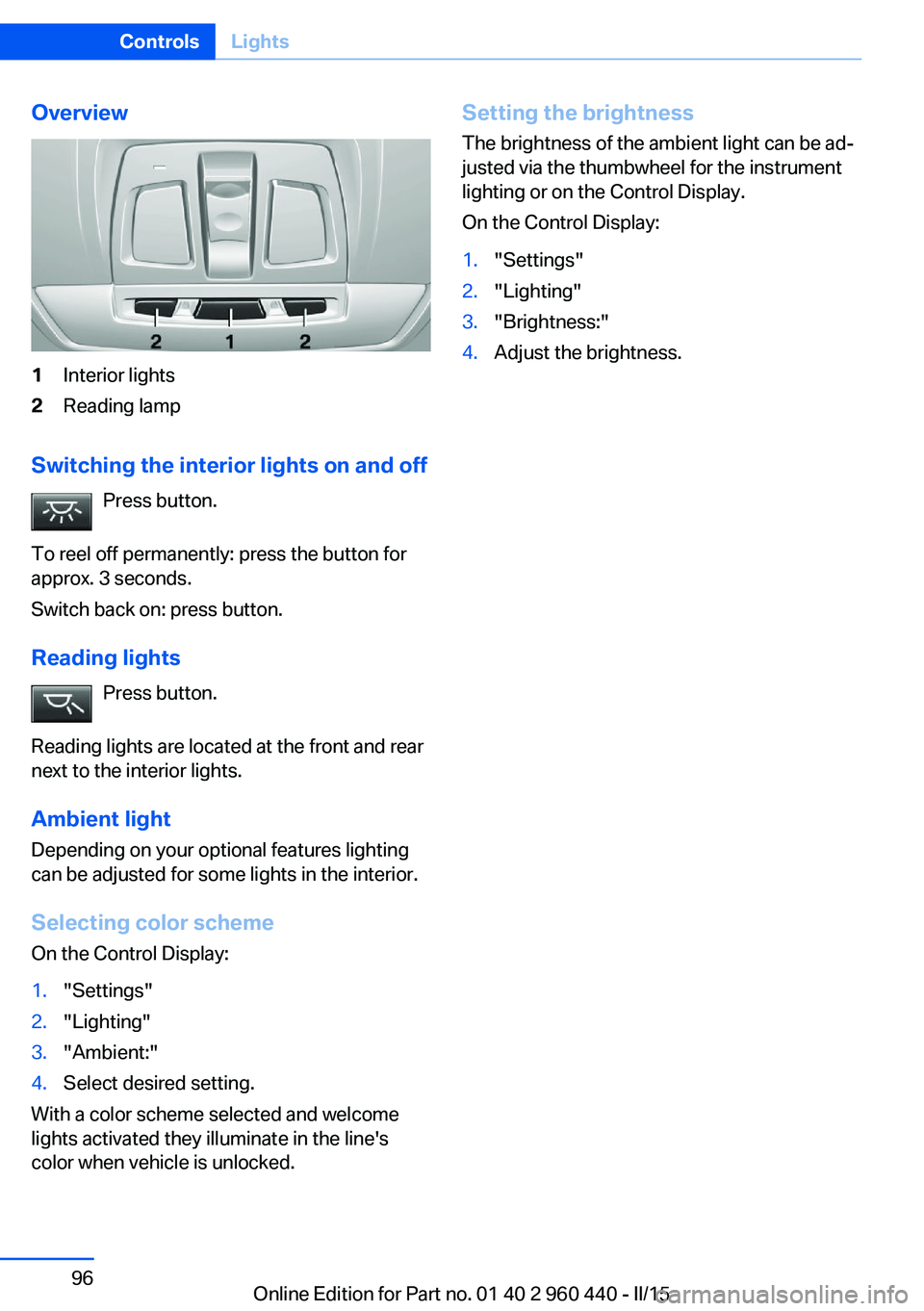
Overview1Interior lights2Reading lamp
Switching the interior lights on and offPress button.
To reel off permanently: press the button for
approx. 3 seconds.
Switch back on: press button.
Reading lights Press button.
Reading lights are located at the front and rear
next to the interior lights.
Ambient light Depending on your optional features lighting
can be adjusted for some lights in the interior.
Selecting color scheme
On the Control Display:
1."Settings"2."Lighting"3."Ambient:"4.Select desired setting.
With a color scheme selected and welcome
lights activated they illuminate in the line's
color when vehicle is unlocked.
Setting the brightness
The brightness of the ambient light can be ad‚Äź
justed via the thumbwheel for the instrument
lighting or on the Control Display.
On the Control Display:1."Settings"2."Lighting"3."Brightness:"4.Adjust the brightness.Seite 96ControlsLights96
Online Edition for Part no. 01 40 2 960 440 - II/15
Page 102 of 257
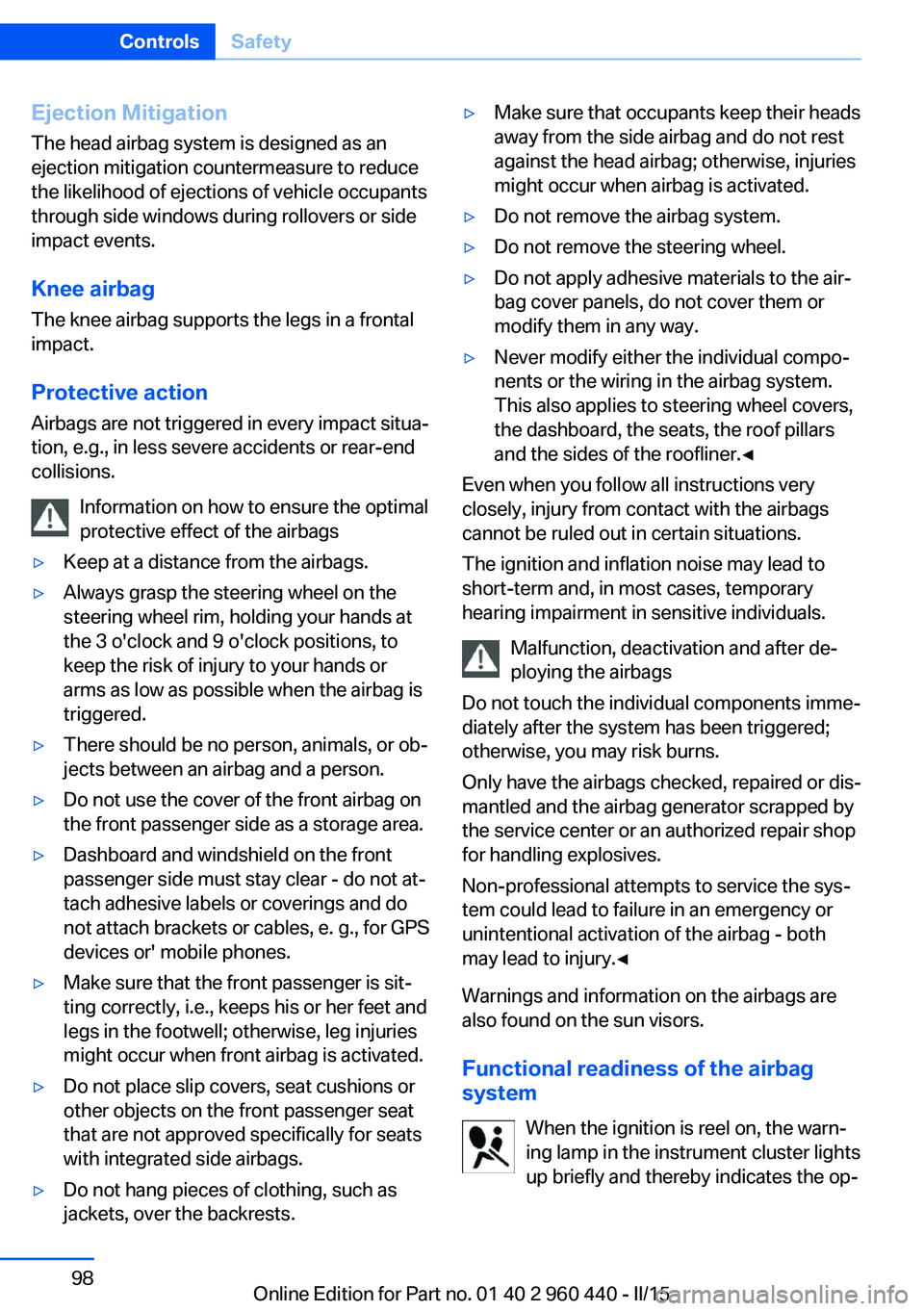
Ejection MitigationThe head airbag system is designed as an
ejection mitigation countermeasure to reduce
the likelihood of ejections of vehicle occupants
through side windows during rollovers or side
impact events.
Knee airbag The knee airbag supports the legs in a frontal
impact.
Protective action
Airbags are not triggered in every impact situa‚Äź
tion, e.g., in less severe accidents or rear-end
collisions.
Information on how to ensure the optimal
protective effect of the airbags‚Ė∑Keep at a distance from the airbags.‚Ė∑Always grasp the steering wheel on the
steering wheel rim, holding your hands at
the 3 o'clock and 9 o'clock positions, to
keep the risk of injury to your hands or
arms as low as possible when the airbag is
triggered.‚Ė∑There should be no person, animals, or ob‚Äź
jects between an airbag and a person.‚Ė∑Do not use the cover of the front airbag on
the front passenger side as a storage area.‚Ė∑Dashboard and windshield on the front
passenger side must stay clear - do not at‚Äź
tach adhesive labels or coverings and do
not attach brackets or cables, e. g., for GPS
devices or' mobile phones.‚Ė∑Make sure that the front passenger is sit‚Äź
ting correctly, i.e., keeps his or her feet and
legs in the footwell; otherwise, leg injuries
might occur when front airbag is activated.‚Ė∑Do not place slip covers, seat cushions or
other objects on the front passenger seat
that are not approved specifically for seats
with integrated side airbags.‚Ė∑Do not hang pieces of clothing, such as
jackets, over the backrests.‚Ė∑Make sure that occupants keep their heads
away from the side airbag and do not rest
against the head airbag; otherwise, injuries
might occur when airbag is activated.‚Ė∑Do not remove the airbag system.‚Ė∑Do not remove the steering wheel.‚Ė∑Do not apply adhesive materials to the air‚Äź
bag cover panels, do not cover them or
modify them in any way.‚Ė∑Never modify either the individual compo‚Äź
nents or the wiring in the airbag system.
This also applies to steering wheel covers,
the dashboard, the seats, the roof pillars
and the sides of the roofliner.‚óÄ
Even when you follow all instructions very
closely, injury from contact with the airbags
cannot be ruled out in certain situations.
The ignition and inflation noise may lead to
short-term and, in most cases, temporary
hearing impairment in sensitive individuals.
Malfunction, deactivation and after de‚Äź
ploying the airbags
Do not touch the individual components imme‚Äź
diately after the system has been triggered;
otherwise, you may risk burns.
Only have the airbags checked, repaired or dis‚Äź
mantled and the airbag generator scrapped by
the service center or an authorized repair shop
for handling explosives.
Non-professional attempts to service the sys‚Äź
tem could lead to failure in an emergency or
unintentional activation of the airbag - both
may lead to injury.‚óÄ
Warnings and information on the airbags are also found on the sun visors.
Functional readiness of the airbag
system
When the ignition is reel on, the warn‚Äź
ing lamp in the instrument cluster lights
up briefly and thereby indicates the op‚Äź
Seite 98ControlsSafety98
Online Edition for Part no. 01 40 2 960 440 - II/15
Page 122 of 257
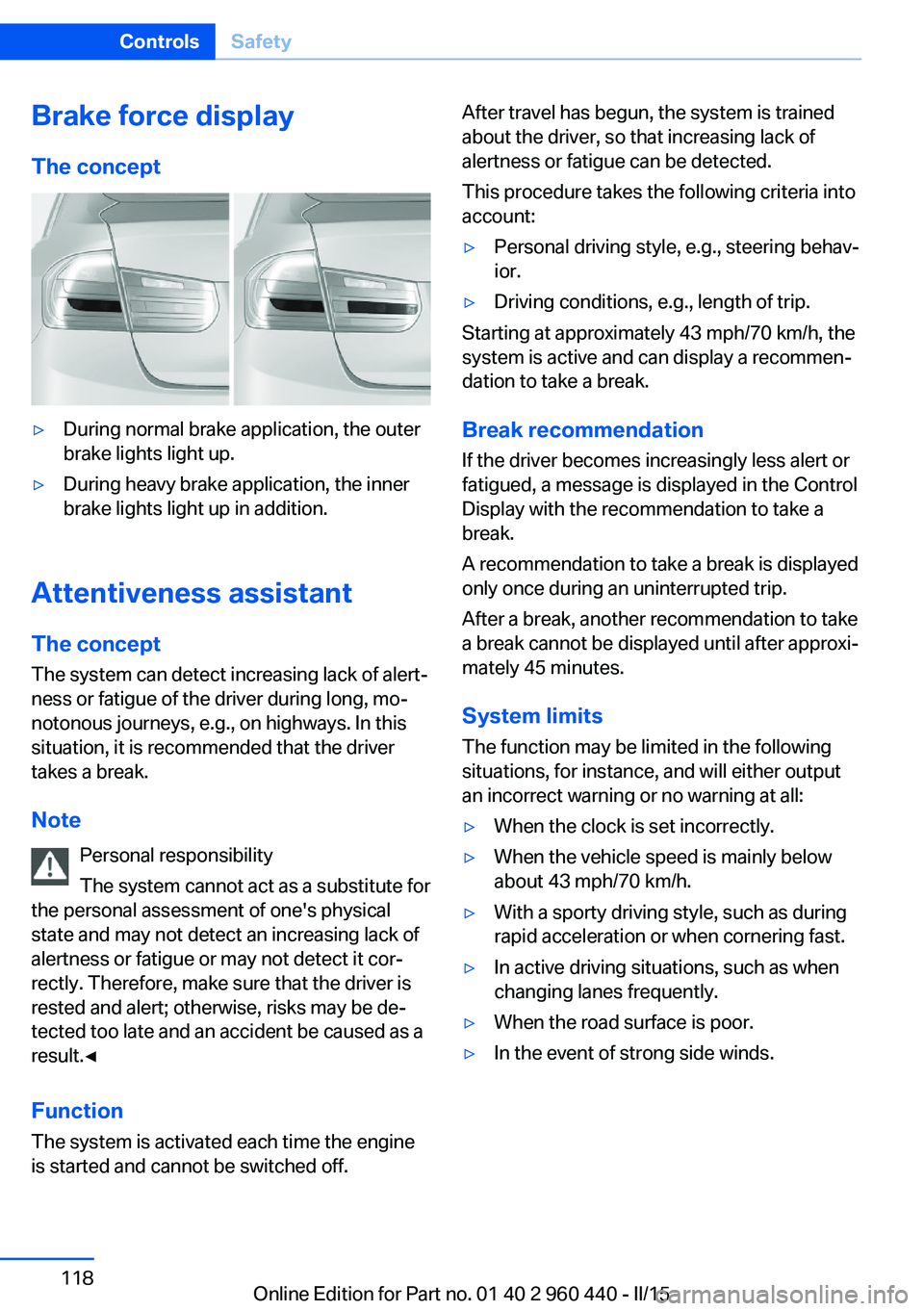
Brake force display
The concept‚Ė∑During normal brake application, the outer
brake lights light up.‚Ė∑During heavy brake application, the inner
brake lights light up in addition.
Attentiveness assistant
The concept The system can detect increasing lack of alert‚Äź
ness or fatigue of the driver during long, mo‚Äź
notonous journeys, e.g., on highways. In this
situation, it is recommended that the driver
takes a break.
Note Personal responsibility
The system cannot act as a substitute for
the personal assessment of one's physical
state and may not detect an increasing lack of
alertness or fatigue or may not detect it cor‚Äź
rectly. Therefore, make sure that the driver is
rested and alert; otherwise, risks may be de‚Äź
tected too late and an accident be caused as a
result.‚óÄ
Function
The system is activated each time the engine
is started and cannot be switched off.
After travel has begun, the system is trained
about the driver, so that increasing lack of
alertness or fatigue can be detected.
This procedure takes the following criteria into
account:‚Ė∑Personal driving style, e.g., steering behav‚Äź
ior.‚Ė∑Driving conditions, e.g., length of trip.
Starting at approximately 43 mph/70 km/h, the
system is active and can display a recommen‚Äź
dation to take a break.
Break recommendation
If the driver becomes increasingly less alert or
fatigued, a message is displayed in the Control
Display with the recommendation to take a
break.
A recommendation to take a break is displayed
only once during an uninterrupted trip.
After a break, another recommendation to take
a break cannot be displayed until after approxi‚Äź
mately 45 minutes.
System limits
The function may be limited in the following
situations, for instance, and will either output
an incorrect warning or no warning at all:
‚Ė∑When the clock is set incorrectly.‚Ė∑When the vehicle speed is mainly below
about 43 mph/70 km/h.‚Ė∑With a sporty driving style, such as during
rapid acceleration or when cornering fast.‚Ė∑In active driving situations, such as when
changing lanes frequently.‚Ė∑When the road surface is poor.‚Ė∑In the event of strong side winds.Seite 118ControlsSafety118
Online Edition for Part no. 01 40 2 960 440 - II/15
Page 123 of 257
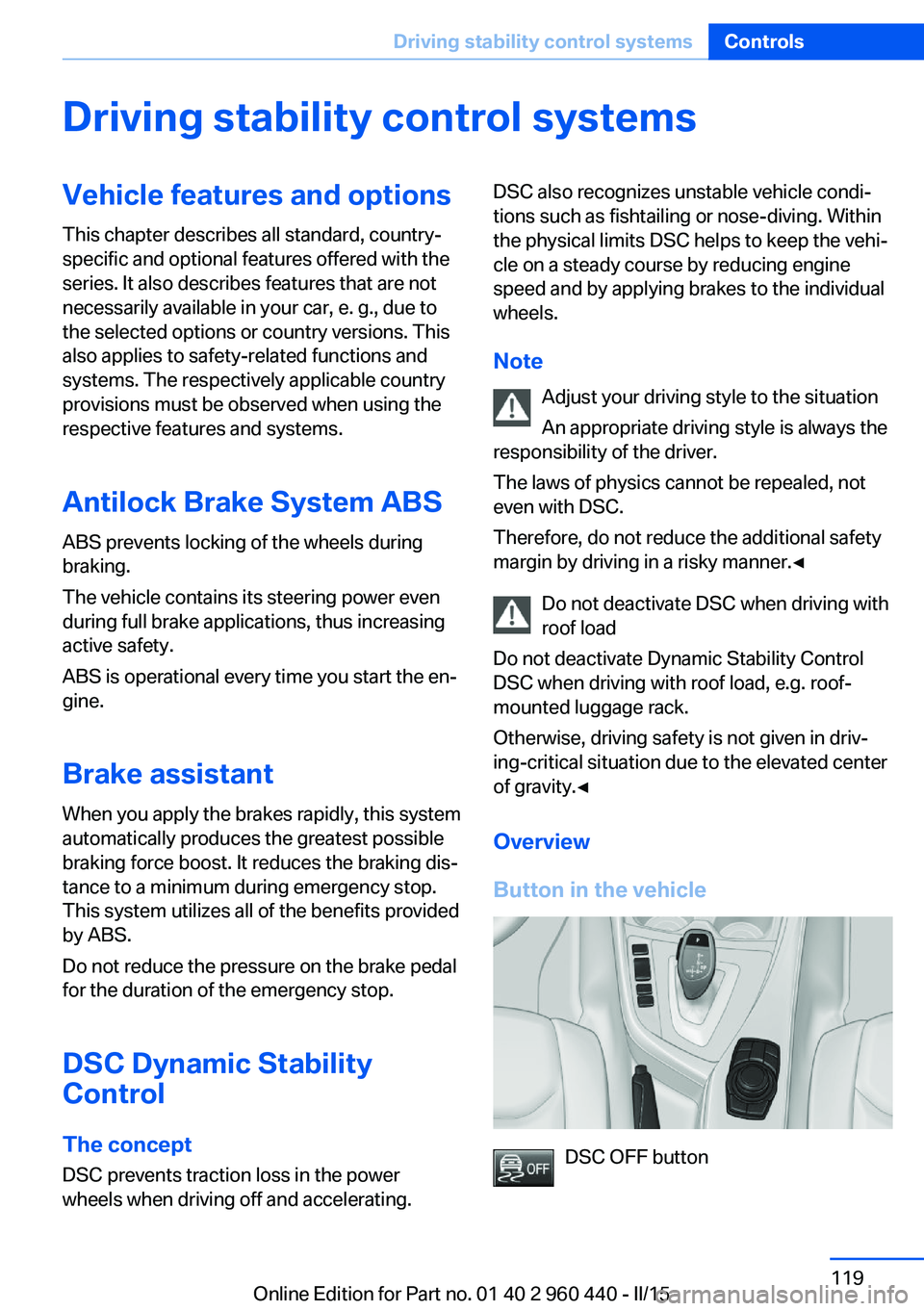
Driving stability control systemsVehicle features and optionsThis chapter describes all standard, country-
specific and optional features offered with the
series. It also describes features that are not
necessarily available in your car, e. g., due to
the selected options or country versions. This
also applies to safety-related functions and
systems. The respectively applicable country
provisions must be observed when using the
respective features and systems.
Antilock Brake System ABS ABS prevents locking of the wheels during
braking.
The vehicle contains its steering power even
during full brake applications, thus increasing
active safety.
ABS is operational every time you start the en‚Äź
gine.
Brake assistant When you apply the brakes rapidly, this system
automatically produces the greatest possible
braking force boost. It reduces the braking dis‚Äź
tance to a minimum during emergency stop.
This system utilizes all of the benefits provided
by ABS.
Do not reduce the pressure on the brake pedal
for the duration of the emergency stop.
DSC Dynamic Stability
Control
The concept DSC prevents traction loss in the power
wheels when driving off and accelerating.DSC also recognizes unstable vehicle condi‚Äź
tions such as fishtailing or nose-diving. Within
the physical limits DSC helps to keep the vehi‚Äź
cle on a steady course by reducing engine
speed and by applying brakes to the individual
wheels.
Note Adjust your driving style to the situation
An appropriate driving style is always the
responsibility of the driver.
The laws of physics cannot be repealed, not
even with DSC.
Therefore, do not reduce the additional safety
margin by driving in a risky manner.‚óÄ
Do not deactivate DSC when driving with
roof load
Do not deactivate Dynamic Stability Control DSC when driving with roof load, e.g. roof-
mounted luggage rack.
Otherwise, driving safety is not given in driv‚Äź
ing-critical situation due to the elevated center
of gravity.‚óÄ
Overview
Button in the vehicle
DSC OFF button
Seite 119Driving stability control systemsControls119
Online Edition for Part no. 01 40 2 960 440 - II/15
Page 151 of 257
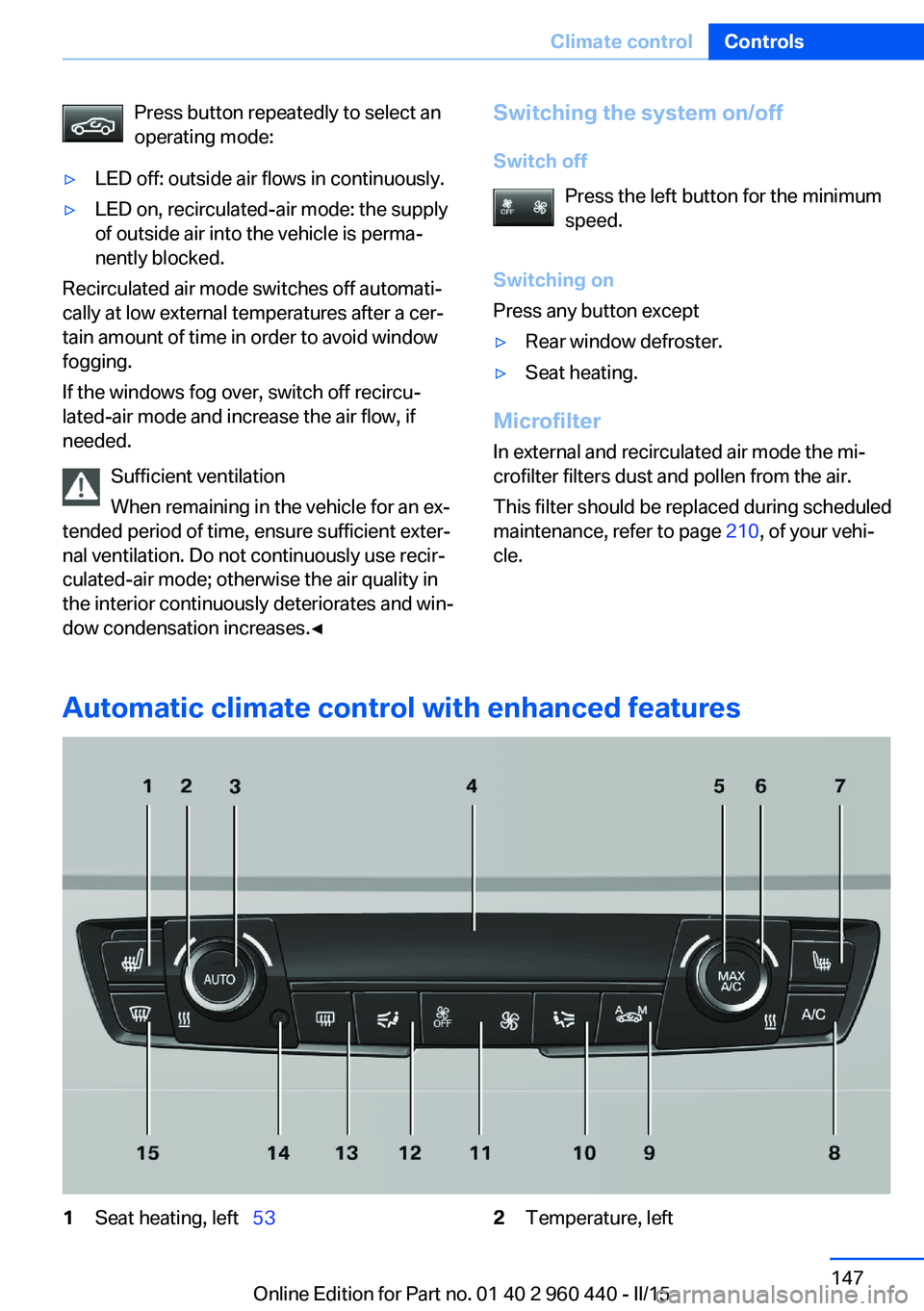
Press button repeatedly to select an
operating mode:‚Ė∑LED off: outside air flows in continuously.‚Ė∑LED on, recirculated-air mode: the supply
of outside air into the vehicle is perma‚Äź
nently blocked.
Recirculated air mode switches off automati‚Äź
cally at low external temperatures after a cer‚Äź
tain amount of time in order to avoid window
fogging.
If the windows fog over, switch off recircu‚Äź
lated-air mode and increase the air flow, if
needed.
Sufficient ventilation
When remaining in the vehicle for an ex‚Äź
tended period of time, ensure sufficient exter‚Äź
nal ventilation. Do not continuously use recir‚Äź
culated-air mode; otherwise the air quality in
the interior continuously deteriorates and win‚Äź
dow condensation increases.‚óÄ
Switching the system on/off
Switch off Press the left button for the minimum
speed.
Switching on
Press any button except‚Ė∑Rear window defroster.‚Ė∑Seat heating.
Microfilter
In external and recirculated air mode the mi‚Äź
crofilter filters dust and pollen from the air.
This filter should be replaced during scheduled
maintenance, refer to page 210, of your vehi‚Äź
cle.
Automatic climate control with enhanced features
1Seat heating, left‚Äā‚ÄÖ 532Temperature, leftSeite 147Climate controlControls147
Online Edition for Part no. 01 40 2 960 440 - II/15
Page 153 of 257
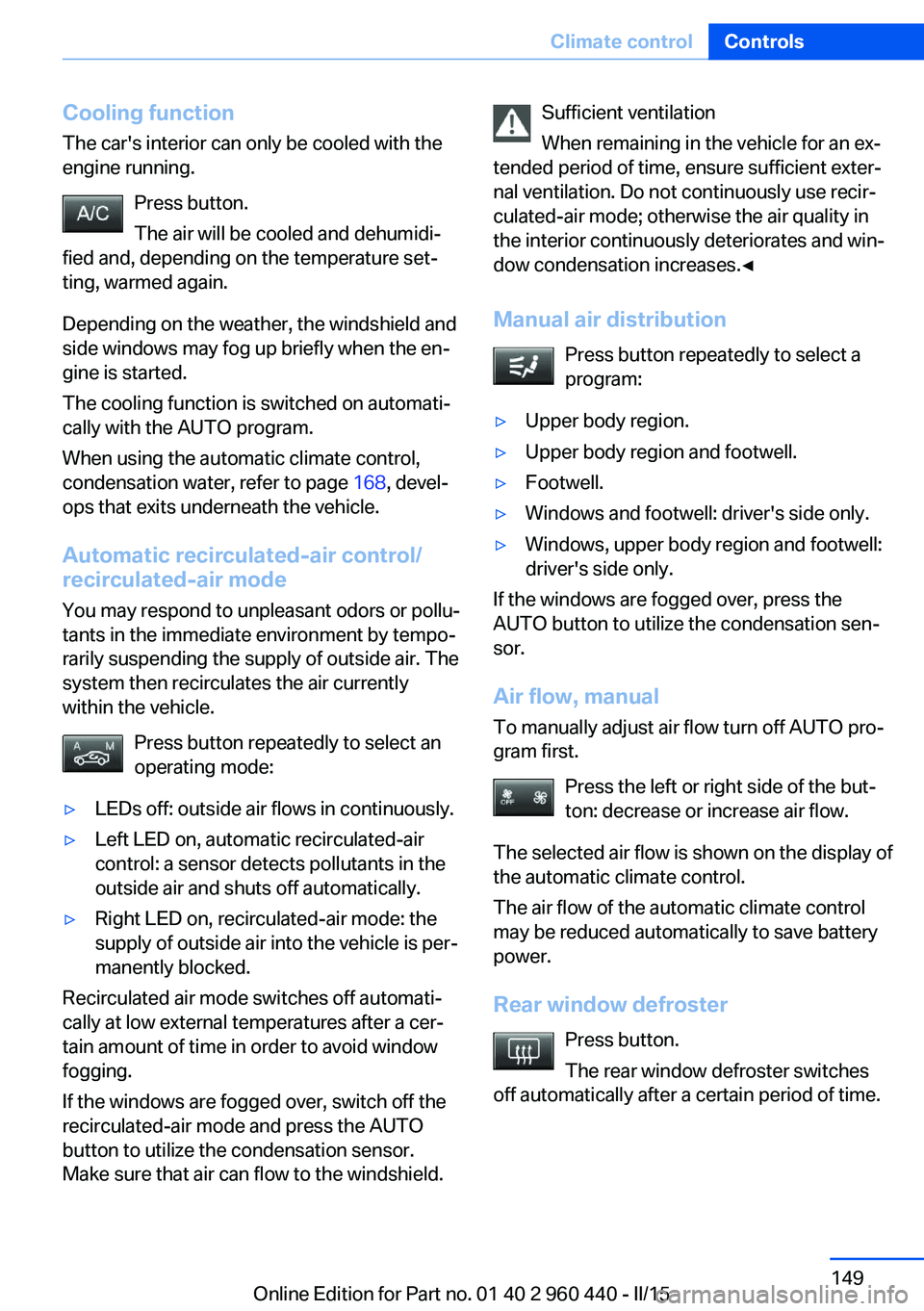
Cooling functionThe car's interior can only be cooled with the
engine running.
Press button.
The air will be cooled and dehumidi‚Äź
fied and, depending on the temperature set‚Äź
ting, warmed again.
Depending on the weather, the windshield and
side windows may fog up briefly when the en‚Äź
gine is started.
The cooling function is switched on automati‚Äź
cally with the AUTO program.
When using the automatic climate control,
condensation water, refer to page 168, devel‚Äź
ops that exits underneath the vehicle.
Automatic recirculated-air control/
recirculated-air mode
You may respond to unpleasant odors or pollu‚Äź
tants in the immediate environment by tempo‚Äź
rarily suspending the supply of outside air. The
system then recirculates the air currently
within the vehicle.
Press button repeatedly to select an
operating mode:‚Ė∑LEDs off: outside air flows in continuously.‚Ė∑Left LED on, automatic recirculated-air
control: a sensor detects pollutants in the
outside air and shuts off automatically.‚Ė∑Right LED on, recirculated-air mode: the
supply of outside air into the vehicle is per‚Äź
manently blocked.
Recirculated air mode switches off automati‚Äź
cally at low external temperatures after a cer‚Äź
tain amount of time in order to avoid window
fogging.
If the windows are fogged over, switch off the
recirculated-air mode and press the AUTO
button to utilize the condensation sensor.
Make sure that air can flow to the windshield.
Sufficient ventilation
When remaining in the vehicle for an ex‚Äź
tended period of time, ensure sufficient exter‚Äź
nal ventilation. Do not continuously use recir‚Äź
culated-air mode; otherwise the air quality in
the interior continuously deteriorates and win‚Äź
dow condensation increases.‚óÄ
Manual air distribution Press button repeatedly to select a
program:‚Ė∑Upper body region.‚Ė∑Upper body region and footwell.‚Ė∑Footwell.‚Ė∑Windows and footwell: driver's side only.‚Ė∑Windows, upper body region and footwell:
driver's side only.
If the windows are fogged over, press the
AUTO button to utilize the condensation sen‚Äź
sor.
Air flow, manual
To manually adjust air flow turn off AUTO pro‚Äź
gram first.
Press the left or right side of the but‚Äź
ton: decrease or increase air flow.
The selected air flow is shown on the display of
the automatic climate control.
The air flow of the automatic climate control
may be reduced automatically to save battery
power.
Rear window defroster Press button.
The rear window defroster switches
off automatically after a certain period of time.
Seite 149Climate controlControls149
Online Edition for Part no. 01 40 2 960 440 - II/15
Page 162 of 257
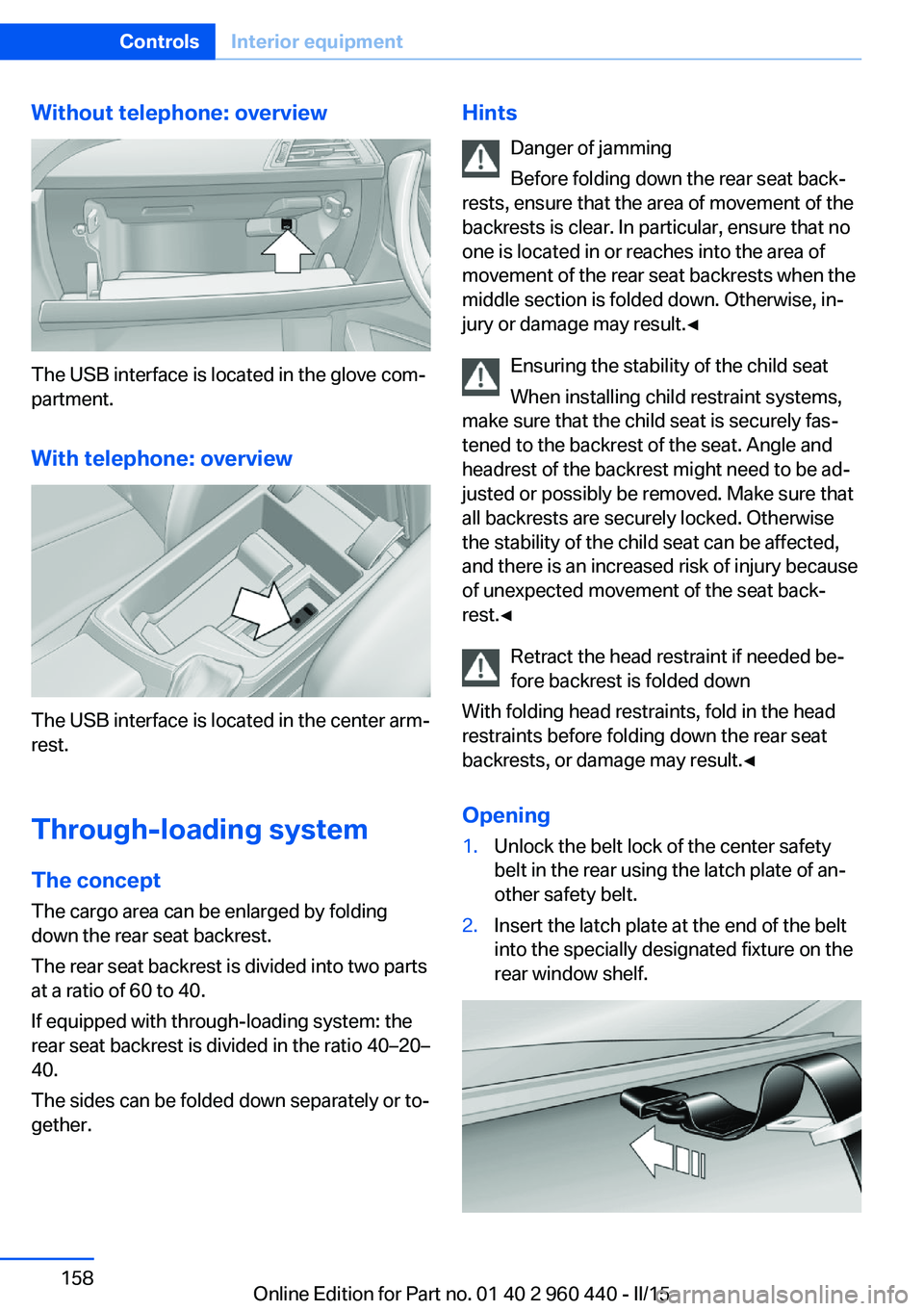
Without telephone: overview
The USB interface is located in the glove com‚Äź
partment.
With telephone: overview
The USB interface is located in the center arm‚Äź
rest.
Through-loading system The concept The cargo area can be enlarged by folding
down the rear seat backrest.
The rear seat backrest is divided into two parts at a ratio of 60 to 40.
If equipped with through-loading system: the
rear seat backrest is divided in the ratio 40‚Äď20‚Äď
40.
The sides can be folded down separately or to‚Äź
gether.
Hints
Danger of jamming
Before folding down the rear seat back‚Äź
rests, ensure that the area of movement of the
backrests is clear. In particular, ensure that no
one is located in or reaches into the area of
movement of the rear seat backrests when the
middle section is folded down. Otherwise, in‚Äź
jury or damage may result.‚óÄ
Ensuring the stability of the child seat
When installing child restraint systems,
make sure that the child seat is securely fas‚Äź
tened to the backrest of the seat. Angle and
headrest of the backrest might need to be ad‚Äź
justed or possibly be removed. Make sure that
all backrests are securely locked. Otherwise the stability of the child seat can be affected,
and there is an increased risk of injury because
of unexpected movement of the seat back‚Äź rest.‚óÄ
Retract the head restraint if needed be‚Äź
fore backrest is folded down
With folding head restraints, fold in the head
restraints before folding down the rear seat
backrests, or damage may result.‚óÄ
Opening1.Unlock the belt lock of the center safety
belt in the rear using the latch plate of an‚Äź
other safety belt.2.Insert the latch plate at the end of the belt
into the specially designated fixture on the
rear window shelf.Seite 158ControlsInterior equipment158
Online Edition for Part no. 01 40 2 960 440 - II/15
Page 163 of 257
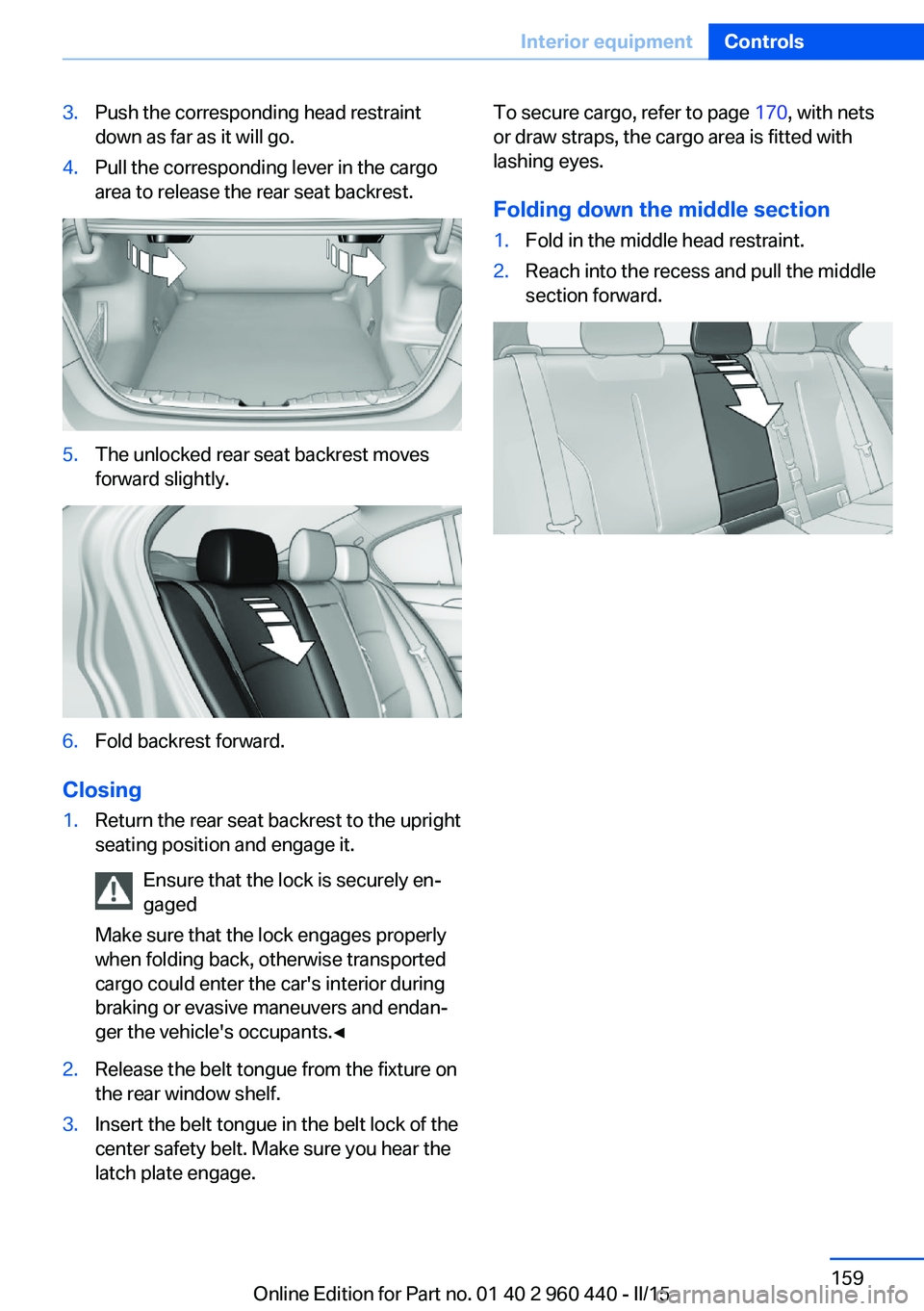
3.Push the corresponding head restraint
down as far as it will go.4.Pull the corresponding lever in the cargo
area to release the rear seat backrest.5.The unlocked rear seat backrest moves
forward slightly.6.Fold backrest forward.
Closing
1.Return the rear seat backrest to the upright
seating position and engage it.
Ensure that the lock is securely en‚Äź
gaged
Make sure that the lock engages properly
when folding back, otherwise transported
cargo could enter the car's interior during
braking or evasive maneuvers and endan‚Äź
ger the vehicle's occupants.‚óÄ2.Release the belt tongue from the fixture on
the rear window shelf.3.Insert the belt tongue in the belt lock of the
center safety belt. Make sure you hear the
latch plate engage.To secure cargo, refer to page 170, with nets
or draw straps, the cargo area is fitted with
lashing eyes.
Folding down the middle section1.Fold in the middle head restraint.2.Reach into the recess and pull the middle
section forward.Seite 159Interior equipmentControls159
Online Edition for Part no. 01 40 2 960 440 - II/15